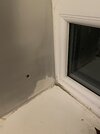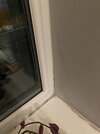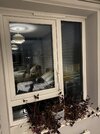I’m looking for some help and advice. I live in a new build and we have a problem with condensation, mould and damp plasterboard around the bedroom windows in the winter. It doesn’t matter what we do inside the house or even if the windows are left slightly open. Once the temperature drops the issue is there.
There wasn’t any filler in the gaps between the window frames so I’ve filled and resealed those but the problem persists. I was told it could be inadequate insulation so I’ve put an inspection camera through the plaster board. I’ll upload the pictures. They essentially show the plasterboard then a cavity, a foil membrane then what is going on behind that between the studs. To my admittedly untrained eye there doesn’t seem to be enough insulation to be effective and I assumed that there wouldn’t be a cavity between the plasterboard and the membrane.
Could this be causing the issue? Any help and advice from people in the know would be greatly appreciated.
There wasn’t any filler in the gaps between the window frames so I’ve filled and resealed those but the problem persists. I was told it could be inadequate insulation so I’ve put an inspection camera through the plaster board. I’ll upload the pictures. They essentially show the plasterboard then a cavity, a foil membrane then what is going on behind that between the studs. To my admittedly untrained eye there doesn’t seem to be enough insulation to be effective and I assumed that there wouldn’t be a cavity between the plasterboard and the membrane.
Could this be causing the issue? Any help and advice from people in the know would be greatly appreciated.







